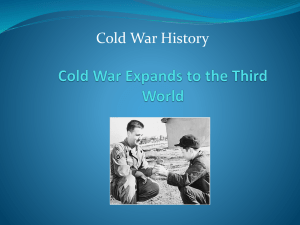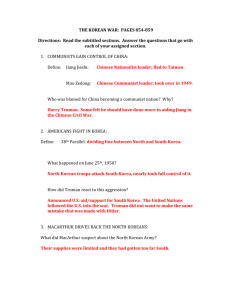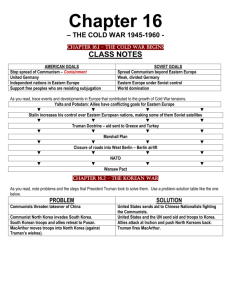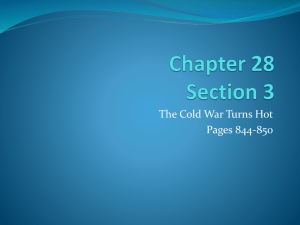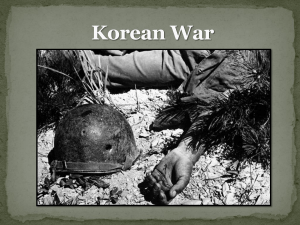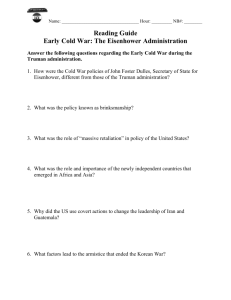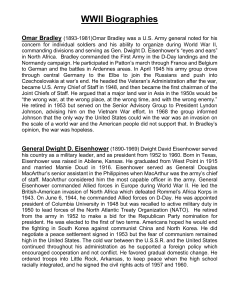Chapter 19 Section 3
advertisement
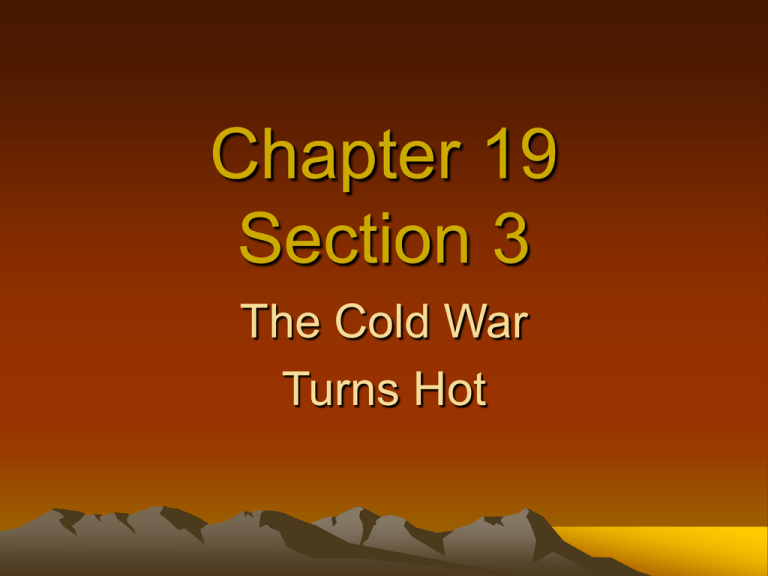
Chapter 19
Section 3
The Cold War
Turns Hot
Communist Victory in China
• A revolution in 1911 left China a chaotic republic
• Upset with the republic and inspired by the Bolshevik
Revolution, a group of Chinese students began the Chinese
Communist Party by the mid 1920’s civil war broke out
• Chiang Kai-shek led the nationalist party against the
Communists
• {But then when WWII broke out the Nationalists and the
Communists worked together to join forces against
Japanese attacks}
• When the war ended the civil war continued.
• The Communists had kept Japan from taking northwest China
and {the Chinese Communist Party leader Mao Zedong} gave
that land to Chinese peasants. This won him support and
increased army recruits
Chiang Kai-shek
Mao Zedong
Continued….
• The U.S. did not want China to become a communist
country
• During WWII the U.S. sent troops and supplies to
China to unite them under the Nationalists
• President Truman sent General George C. Marshall to
China in 1945 to negotiate a truce between the two
parties
• Neither Chiang nor Mao would compromise
• By 1949 Mao had gained control of most of China
• Realizing defeat, Chiang and his troops fled to Taiwan
• {The Communists prevailed in China; thus, The
Peoples Republic of China was established}
• The U.S. refused to recognize the new government
The Korean War Begins
• At the end of WWII in 1945 the Allies divided Korea into two
zones. Soviets occupied the north zone and U.S. troops held the
south
• In 1948, North Korea and South Korea set up separate
governments
• Communist North Korea led by Kim il Sung became known as
the Democratic Peoples Republic of Korea
• {South Korea under President Syngman Rhee called itself the
Republic of Korea}
• By 1949 the U.S. and the S.U. had withdrawn troops from Korea,
leaving the Korean armies facing each other at the border
• June 25, 1950 North Korea invaded South Korea
• The U.N. Security Council called for a cease-fire
• On June 27, Truman pledged his support for South Korea
Bitter Fighting
• {The U.S. troops were sent into action in South Korea under
General Douglas MacArthur.}
• The U.S. and South Korea were at first overwhelmed. After all
North Korea had the Soviet Union and Communist China close
by to restock supplies and weapons
• By September, the North Koreans had nearly taken all of South
Korea
• The U.S. and S.K. forced were backed into an area around the
city of Pusan
• On September 15, 1950, MacArthur launched a counterattack
in which they were able to push forward and recapture Seoul
• Other UN armies that remained around Pusan attacked the
North Koreans from the south.
Continued….
• North Koreans were surrendering by the thousands
• The UN armies began to advance to the Yalu River (the border
between China and North Korea)
• Then the tables turned when China sent some 300,000 troops
across the Yalu
• This was the first time that China directly intervened in the war
• Outnumbered the UN forces fell back
• After much fighting MacArthur was able to establish a defensive
line near the 38th parallel.
• With the involvement of China now being an issue MacArthur
called for a major expansion of the war
• He called for the blockade of China’s coast and the bombing of
its interior, then to let loose Chiang’s forces to invade the
mainland
Conflict Between Truman and
MacArthur
• MacArthur’s plan received mixed reactions, some believed that
an attack on China would bring the S.U. into the conflict and
spark another world war.
• President Truman was among those who opposed the attack on
China
• MacArthur blatantly defied Truman and appealed to Congress
and gave the enemy an ultimatum for unconditional surrender
• This severely upset Truman’s plans for peaceful negotiations so
{Truman had MacArthur removed from his post in April 1951.
• The general public was upset with Truman’s actions.} {They
gave MacArthur a hero’s welcome} and began booing the
president during his public appearances
• Over the next several months, the American death toll
increased
• This became a huge issue in the election of 1952
The Election of 1952
• With the war at a stalemate and peace talks doing little to no
good, Truman decided not to run for office again
• {The Republican's chose WWII hero Dwight D. Eisenhower to
run with Richard Nixon as his running mate}
• The Democratic nominations was Adlai Stephenson
• Stephenson was no match for Eisenhower’s patriotic appeal.
• Eisenhower received 55% of the popular vote and won the
electoral vote 442 to 89
• President Eisenhower kept his promise to end the war.
• Eisenhower stepped up bombing raids and insinuated to North
Korea that he would use nuclear weapons if necessary.
• On July 27, 1953 they agreed to an ceasefire and kept the
country divided at the 38th parallel
Fighting Communism Abroad
• Eisenhower’s team suggested a policy of brinkmanship, or the
threat of all out war in order to confront Communism, including
the use of nuclear weapons.
• Eisenhower instead went with a more covert and diplomatic
policy
• {He used the Central Intelligence Agency to gather strategic
information and undergo covert missions}
• He first tested his policy in Iran where he succeeded in
removing Mohammad Mosaddeq
• But this interference in Iranian affairs provoked anti-American
feelings in Iran
• He then moved on to Guatemala, where he suspected the
democratically elected president of being sympathetic to
communism because he was giving land to poor people
• CIA-led forces bombed the capital in June 1954 and installed a
new pro-US government
• Now Latin America had animosity towards the U.S. too.
The Story Behind The Story
The CIA involvement in Guatemala was a lot more about fruit than about
communism and the Cold War. However, the Cold War ethos was a guise to what
was really behind the covert actions of the government which was ultimately seen
as the most successful coup in CIA history.
The power of the fear of communism turned out to be a helpful aid in the economic
plights of Washington. Although the threat of communistic expansion in Latin
America was real, the United States Government saw another problem arising in
the country of Guatemala where the United States run United Fruit Company, a
business that had been introduced into Guatemala in 1904, was having problems
with the president Jacobo Arbenz Guzman in the 50s. Arbenz became the leader of
Guatemala in 1951. His plans were to immediately take control over the country
through independent development. He saw the impoverishment of his fellow
countrymen as the fat cats of America growing fatter off his land and realized that
there must be change. President Arbenz saw the UNFCO as the reason why
Guatemala continued to be underdeveloped, and made plans to stop the
"stranglehold" that the company had over the country. The company which had
strong influence in Washington was not about to let this happen, therefore the CIA
organized an intricate plan to overthrow Arbenz; this plan worked.
The Suez Crisis
• Sometimes Eisenhower did use diplomacy rather than
aggressive actions to deal
• In 1955 after the U.S. withdrew an offer to finance a dam in
Egypt, Egyptian leader nationalized the Suez Canal
• As a result, the western oil trade was threatened and Egypt
began to refuse to allow ships that were bound for Israel to pas
through
• In October, Israel attacked Egyptian territory near the Suez
canal. Britain and France interfered and seized the waterway.
The S.U. threatened war if the nations did not leave Egypt
• Eisenhower swooped in and persuaded a reluctant, Britain,
France and Israel to let it go and the conflict eased
• In order to counter the new relationship between the S.U. and
the Arabs, Eisenhower issued the Eisenhower Doctrine, which
offered military aid to any Middle Eastern nation seeking help to
resist Communist aggression
Uprising in Eastern Europe
• {After Stalin died in 1953, Nikita Khrushchev took his place.}
He accused Stalin of committing ruthless crimes
• Hoping that this accusation would allow for reform, Polish
reformers began calling for more political freedom
• Inspired by Poland, thousands of Hungarians stormed the
streets to demand reform, seized control of the government and
called for a Western-style democracy and for succession from
the Warsaw Pact.
• Khrushchev quickly moved troops into Budapest, imposed
martial law and imprisoned or executed the rebel leaders
• Despite pleas, Eisenhower refused to send aid to Hungary for
fear of starting a war. He did, however, loosen immigration laws
that allowed about 40,000 Hungarians to flee to the U.S.
Soviet troops in Budapest
Nikita Khrushchev
A Brief Thaw in the Cold War
• In the late 1950’s the U.S. and the S.U. made efforts to improve
their relationship
• In 1959, Vice President Richard Nixon visited the Soviet Union
• Then Premier Khrushchev came to the U.S.
• He and Eisenhower agreed to meet in Paris the following year
to discuss arms reductions
• Right before that conference was supposed to take place,
Khrushchev announced that an American U-2 spy plane had
been shot down over the S.U.
• The U.S. tried to lie and say that is was a weather research
plane, but the pilot had been captured and admitted he was on
a spying mission
• Khrushchev refused to go to the Paris meeting unless the U.S.
stopped the spy missions and apologized
• Eisenhower promised the U-2 flights would stop, but refused to
apologize
• Khrushchev refused to ever meet with Eisenhower again
• These events became known as the U-2 Incident
< The U-2 bomber in flight
The wreckage >
of the U-2
bomber that was
shot down in the
Soviet Union
American Pilot Gary Powers on trial for espionage
